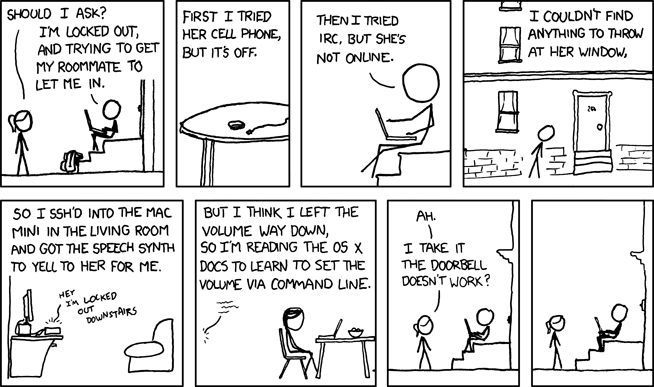Saturday, March 14, 2009
How to Get a Job
And do you want to know what’s the most striking thing about most of these hopefuls? They are completely wasting their time. And mine, of course, but mostly their own. Because they’re not only not going to get a job with me, they’re not going to get a job with anyone unless that person is as slovenly and illiterate as these applicants.
She proceeds to offer some excellent advice in numerous categories. Here are some excerpts from a lengthy list about formatting:
Learn to use style sheets, so that you can make your heading styles consistent. If you choose to ignore my request for a PDF résumé, try to make sure your Word attachment doesn’t demonstrate to me what a slob you are, formatting everything locally and aligning text using spaces instead of tabs.
Don’t Capitalize Everything. I Cannot Emphasize This Enough. It Makes You Look Like a 419 Scammer.
Violet 9pt Arial is probably not a good choice for anything.
Hehe. (sob)
Related to this: How Not to Get a Job (Palimpsest, December 2007)
Of course, in today's economy, lots of people need jobs. So here is some long-promised advice on how to get a job:
Apply for jobs where your skillset is relevant. In this job market, with tons of job seekers, you are unlikely to get the "stretch" position. So, look for positions that are equivalent to your last position, that you are uniquely qualified for, or that you are slightly overqualified for. For instance, let's say you are a technical writer with five years of experience and "the usual" complement of technical skills. What is your unique qualification? If you speak some Japanese, look for Japanese companies where your language skills might be useful. If your undergraduate degree is in music, look for a company that makes music software or products related to music. In other words, look for a position where your outside interests are also relevant. But, at a minimum, apply only for positions that you are reasonably qualified for. It's tempting, especially when you really need a job Right Now, to take the firehose approach and spray resumes everywhere. It doesn't work. Focus your job search and send out a smaller number of really good applications.
Do your homework. Before contacting the company, investigate. Read their web site, read any recent news coverage. Look them up on LinkedIn and see if you know anyone in the organization. (You are on LinkedIn, right?) Use the information you find to make your application more relevant. If you get an interview, do more homework before the interview.
When you apply for the job, follow the #!%$#!%#! instructions. If asked for PDF, provide PDF. If asked for Word, provide Word. Et cetera.
Submit resumes online. Paper and snail mail takes too long. By the time your resume arrives by mail, the position could be filled. Also, dropping off your resume in person? Creepy and needy. (One exception: If you know someone at the organization and they are willing to deliver the resume for you. Even then, I would recommend sending your contact email with the resume and asking him or her to forward it.)
Whether it is requested or not, write a cover letter. The cover letter should be the body of your email and not an attachment. Follow Ms. Amos's excellent advice. You might also use a T letter as your cover letter, but do send the resume. Tom Murrell describes the T letter in detail in his article Get More Interviews with a T-letter. But again, I disagree with his advice to leave out the resume. If you are instructed to send a resume, send a resume.
Show up on time for any in-person interview. If possible, do a dry run the day before to locate the building. Or plan to arrive very early. There are worse things than sitting in a nearby coffee shop for half an hour. (Don't chug too much coffee.)
I could go on for a long time, but frankly, these six points will lift you above 95 percent of the other applicants, and you can do the rest.
What’s a good price to sell my daughter into slavery?
Saudi Court Sentences Elderly Woman to 40 Lashes for 'Mingling'
March 9, 2009 on CNN
A Saudi Arabian court has sentenced a 75-year-old Syrian woman to 40 lashes, four months imprisonment and deportation from the kingdom for having two unrelated men in her house, according to local media reports.
According to the Saudi daily newspaper Al-Watan, troubles for the woman, Khamisa Mohammed Sawadi, began last year when a member of the religious police entered her house in the city of Al-Chamli and found her with two unrelated men, "Fahd" and "Hadian."
Fahd told the policeman he had the right to be there, because Sawadi had breast-fed him as a baby and was therefore considered to be a son to her in Islam, according to Al-Watan. Fahd, 24, added that his friend Hadian was escorting him as he delivered bread for the elderly woman. The policeman then arrested both men.
Read more
Technology Changes the Way We Think
Friday, March 13, 2009
Kosmix--Search
Kosmix: Your Guide to the Web from Kosmix on Vimeo.
Thursday, March 12, 2009
Girl Scout Day (March 12th Special)

Juliette "Daisy" Gordon Low assembled 18 girls from Savannah, Georgia, on March 12, 1912, for a local Girl Scout meeting. She believed that all girls should be given the opportunity to develop physically, mentally, and spiritually. With the goal of bringing girls out of isolated home environments and into community service and the open air, Girl Scouts hiked, played basketball, went on camping trips, learned how to tell time by the stars, and studied first aid.
Within a few years, Daisy's dream for a girl-centered organization was realized. Today, Girl Scouts of the USA has a membership of nearly four million girls and adults, a significant growth from its modest beginnings nearly a century
ago. In fact, more than 50 million women in the U.S. today are Girl Scout alumnae. We invite you to learn about our robust organization and its rich history. From our willingness
to tackle important societal issues, to our commitment to diversity and inclusiveness—Girl Scouts is

dedicated to every girl, everywhere.
· Read Girl Scout founder Juliette Gordon Low's Biography and see how one visionary affected so many lives.
· Track the incredible journey of the Girl Scout Movement on ourTimeline: Decade by Decade.
· Visit our online Museum for an in-depth look at the objects and ephemera that tell the story of the organization from its inception.
· Don't miss the Museum's Featured Exhibit, which highlights Girl Scout uniforms over the years.
· Learn about the beautiful facilities and history of the Edith Macy Conference Center, Girl Scouts of the
· Find out what happened This Month in Girl Scout History to put it all into context.
· Historical Highlights (PDF, 1.7MB): The turn of the century brought Girl Scouting to a threshold of change. In a nutshell, here's what has happened to transform the organization from 2002 to 2008.
My First Blog
Hello!!!
Well this is my first Blog Ever, I may be late but not too late.
So, who am I?
My name is Jeeva, I am an Information Technology Post Graduate!!!
Well I believe that I know a bit of every thing about computers and not only that.
So, why do I Blog?
Just to share my knowledge and gain from your knowledge abut any thing comes across our mind.
I can hear you asking what the gain in this blog is for you.
I Believe knowledge is the most powerful and richest, we are to gain know knowledge.
So, what will be logging about?
I will try to take to fun, entertainment, science, innovations, adventures, stores, good, bad, big, small and many more……
So Friends pleas do comment with suggestion, criticisms, tell me what you think, ask your questions, and Share your views.
Jeeva.






